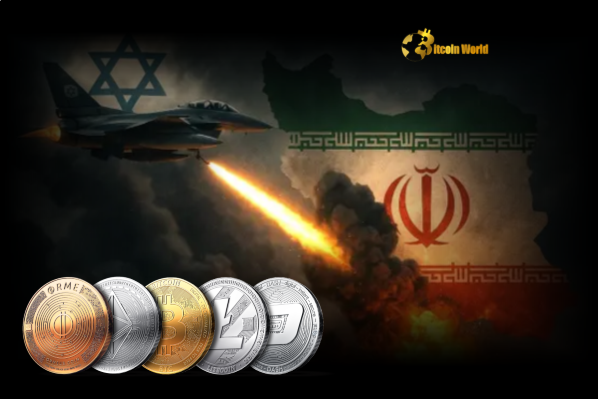BitcoinWorld

Geopolitical Risk: How Escalating US Iran Tensions Could SHOCK the Crypto Market
In the unpredictable world of global finance, events far beyond traditional economic indicators can send ripples through markets. For those invested in cryptocurrencies, understanding these external forces is crucial. Recent reports indicating escalating US Iran tensions highlight a significant geopolitical flashpoint that could potentially trigger substantial crypto market volatility.
Understanding the Escalating US Iran Tensions
The situation between the United States and Iran has seen a worrying uptick in recent weeks. Reports from sources like The New York Times, cited by Walter Bloomberg on X (formerly Twitter), suggest a dangerous preparatory phase. Iran is reportedly positioning missiles and military assets, explicitly capable of targeting U.S. bases, signaling a readiness for direct engagement should Washington become involved in regional conflicts.
This development follows earlier, equally concerning reports. CNN detailed discussions within the White House involving President Trump. The subject? Direct strikes on Iran’s nuclear facilities. These discussions reportedly included considering advanced weaponry, such as bunker-busting bombs and stealth bombers, indicating a serious consideration of military options at the highest levels of the U.S. government.
These reports paint a picture of two nations potentially bracing for conflict, a scenario that historically sends shockwaves across global financial systems.
What Does Potential Iran Conflict Impact Mean for Global Markets?
Geopolitical instability, particularly involving key regions like the Middle East, has a predictable, often negative, impact on traditional financial markets. Here’s a breakdown:
- Stock Markets: Uncertainty typically leads investors to move away from riskier assets. Stock indices often see declines as confidence wanes and future earnings projections become less certain.
- Oil Prices: The Middle East is central to global oil supply. Any conflict there raises fears of supply disruptions, invariably driving oil prices higher. This has cascading effects on inflation and transportation costs globally.
- Safe-Haven Assets: Investors traditionally flock to assets perceived as safe during times of crisis. Gold, government bonds (like U.S. Treasuries), and certain currencies (like the Swiss Franc or Japanese Yen) often see increased demand, driving up their prices.
Understanding these traditional market reactions is key to anticipating how the Iran conflict impact might extend to newer asset classes like cryptocurrency.
The Crypto Connection: Navigating Geopolitical Risk Crypto
For cryptocurrency investors, the link between geopolitical events and digital asset prices is a topic of ongoing debate and observation. While crypto markets operate 24/7 and are decentralized, they are not immune to global sentiment and capital flows. Here’s how geopolitical risk crypto dynamics play out:
Historically, Bitcoin and other cryptocurrencies have shown varying degrees of correlation with traditional markets. Sometimes they act like risk-on assets, falling alongside stocks. At other times, particularly during moments of perceived financial system instability or currency devaluation, they have been argued to function as a form of digital gold or a hedge.
A potential conflict involving Iran introduces multiple factors:
- Increased global uncertainty and fear.
- Potential disruption to global supply chains and energy markets.
- Possible shifts in investor confidence in traditional financial structures.
These factors can influence whether investors view crypto as a place to hide from turmoil or simply another volatile asset to sell off.
Will Crypto Act as a Safe Haven Amidst Middle East Conflict?
The narrative of Bitcoin as ‘digital gold’ gained traction after the 2008 financial crisis and has been tested during subsequent periods of economic and geopolitical stress. The theory is that, being decentralized and outside the control of any single government or central bank, Bitcoin could serve as a store of value when traditional fiat currencies or assets are threatened by conflict, sanctions, or inflation.
However, the reality is complex. While some data points suggest Bitcoin saw inflows during certain crises (like the early days of the COVID-19 pandemic or specific regional currency crises), its price has also often correlated with tech stocks and other risk assets, falling sharply during broader market sell-offs. Its relatively short history compared to gold means its reliability as a safe haven during major, prolonged global conflicts is still being assessed.
A significant Middle East conflict could be another major test for this safe-haven narrative. If the conflict leads to widespread panic selling in traditional markets, crypto could initially be dragged down. Alternatively, if the crisis is perceived as undermining faith in traditional financial systems or currencies, crypto could see increased adoption and demand as an alternative.
Historical Context: Crypto Market Volatility During Past Crises
Looking back at previous geopolitical events provides some clues, though past performance is never a guarantee. The invasion of Ukraine in early 2022, for instance, initially saw Bitcoin dip, but it later showed some resilience compared to traditional assets under certain conditions. Similarly, regional tensions have sometimes led to localized spikes in crypto usage as people sought alternatives to unstable local currencies.
The key takeaway is that crypto market volatility is often amplified during times of high global stress. The market is still relatively smaller and less liquid than traditional markets, making it susceptible to sharper price swings based on news, sentiment, and large capital movements.
Here’s a simplified look at potential market reactions:
| Scenario | Traditional Markets (Stocks, Bonds) | Oil Prices | Gold | Cryptocurrency (Bitcoin, Altcoins) |
|---|---|---|---|---|
| Escalation/Conflict Starts | Likely Sell-off (Risk-Off) | Likely Spike Up | Likely Spike Up (Safe Haven) | Uncertain: Could follow stocks down OR see safe-haven buying |
| Conflict Prolonged | Depends on severity, potential for further declines | High Volatility, sustained high prices likely | Sustained high prices or further gains | High Volatility, correlation may shift over time |
| De-escalation/Resolution | Likely Rally (Risk-On) | Likely Fall Back | Likely Fall Back | Uncertain: Could follow stocks up OR lose safe-haven bid |
This table illustrates the potential uncertainty surrounding crypto’s reaction compared to more established assets.
Actionable Insights for Crypto Investors Amidst Uncertainty
Given the potential for increased crypto market volatility stemming from US Iran tensions and the broader Middle East conflict, what steps can crypto investors consider?
1. Stay Informed, Beyond Crypto News: Pay close attention to global geopolitical developments. News outlets covering international relations, not just crypto-specific sites, become crucial sources of information.
2. Assess Your Risk Tolerance: Understand that periods of high geopolitical stress often mean higher market risk. Are you comfortable holding volatile assets if tensions escalate? Re-evaluating your portfolio’s risk profile is prudent.
3. Diversification Remains Key: While difficult during market-wide moves, ensuring your portfolio isn’t overly concentrated in one asset class (including crypto) can help mitigate losses. Consider traditional safe havens if your strategy allows.
4. Avoid Emotional Decisions: Market crashes or sudden spikes driven by fear can lead to impulsive selling or buying. Have a plan and try to stick to it, focusing on your long-term investment goals rather than reacting to short-term news cycles.
5. Understand the ‘Why’: If you believe in the long-term potential of decentralized technology and crypto as an alternative financial system, view potential dips caused by external factors as separate from the underlying technology’s value proposition.
6. Secure Your Assets: During times of global uncertainty, ensuring your private keys are secure and your assets are not held on potentially vulnerable centralized exchanges (if you prefer self-custody) is always a good practice.
These steps are not financial advice, but general principles for navigating uncertain market conditions.
The Unpredictable Path Ahead
The situation between the U.S. and Iran remains fluid and highly unpredictable. Whether the current tensions de-escalate or unfortunately lead to direct confrontation will significantly shape global markets, including the crypto space. The reports of potential U.S. strikes on nuclear facilities and Iran’s preparedness add a serious dimension to the existing geopolitical risk crypto investors must consider.
While the crypto market’s reaction is not guaranteed to follow traditional patterns, ignoring the potential impact of a major Iran conflict impact would be unwise. The coming days and weeks could be critical in determining the trajectory of this dangerous standoff and its subsequent effects on global finance.
Summary: Staying Prepared in a Tense World
Escalating US Iran tensions, including reports of potential U.S. strikes and Iran’s military preparations, introduce significant geopolitical risk crypto investors must acknowledge. A potential Middle East conflict carries the potential for substantial crypto market volatility. While crypto’s role as a safe haven is still debated and tested, the impact of an Iran conflict impact on global markets will undoubtedly influence digital asset prices. Staying informed, managing risk, and avoiding impulsive reactions are key strategies for navigating these turbulent times.
To learn more about the latest Geopolitics trends, explore our article on key developments shaping Crypto Market price action.
This post Geopolitical Risk: How Escalating US Iran Tensions Could SHOCK the Crypto Market first appeared on BitcoinWorld and is written by Editorial Team





